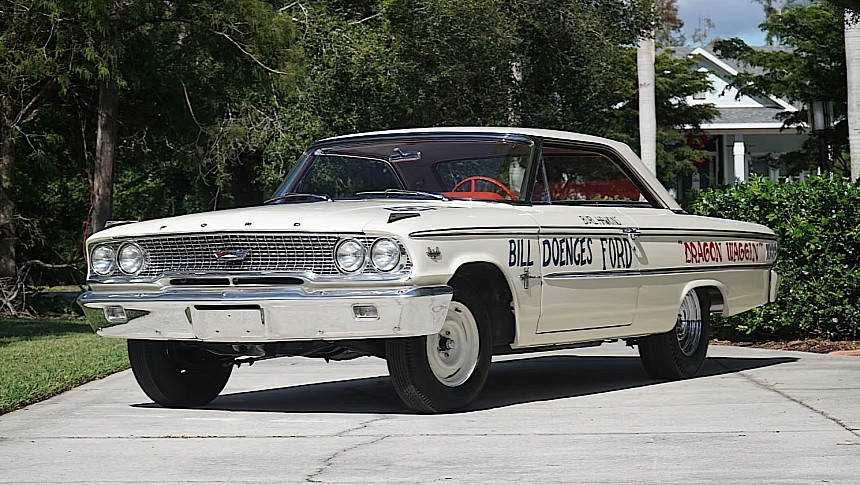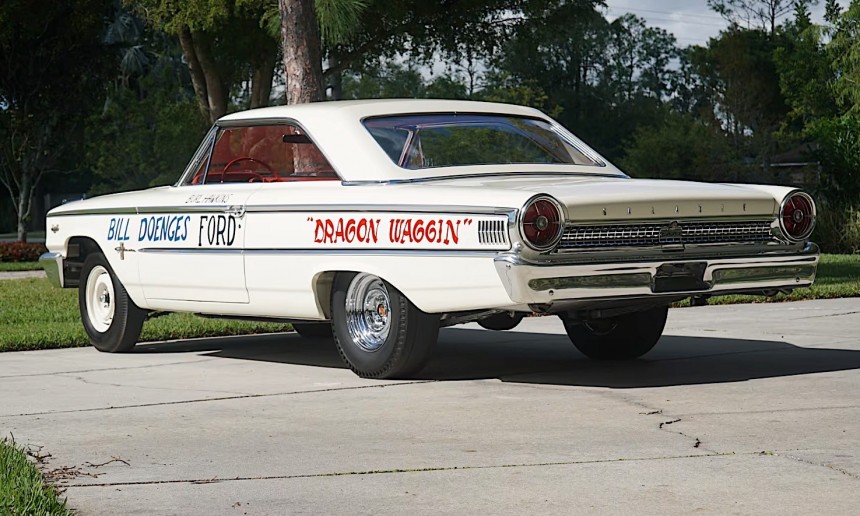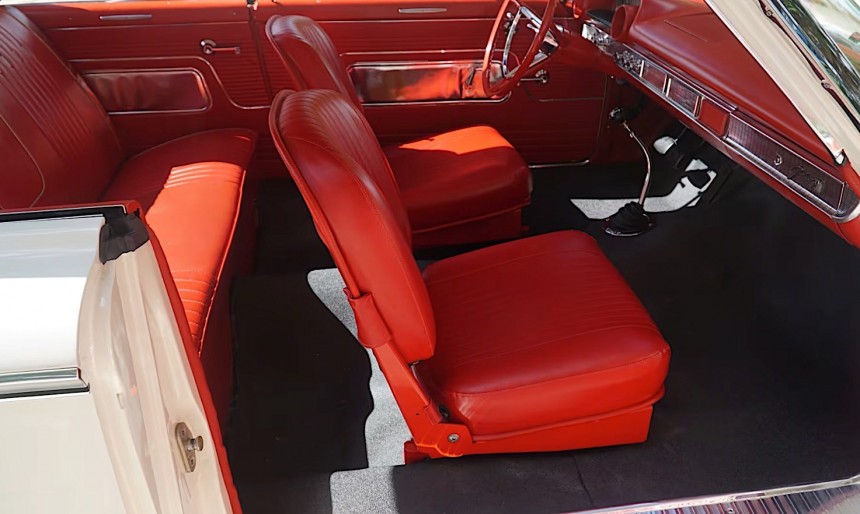Many of history's great cars were born as a result of racing efforts, or more precisely the carmakers' push to comply with regulations while at the same time offering the vehicle the best shot at winning. And the Ford Galaxie 500 Lightweight is just one example of that.
The Galaxie came about in 1958 as a full-sized car, and it was named so as Ford was trying to capitalize on the public's interest in the then-nascent space race. It was successful enough to be kept in production for 15 years and, unlike many of the American-made cars we talk about here, was even sold abroad, more specifically in Australia and Brazil.
It was on the home market where the Galaxie thrived, and it did that to such a degree it even prompted the Blue Oval to rely on it heavily for its Total Performance program.
That's the program that gave birth to the Lightweights as well, machines on four wheels meant to take on rivals in the Super Stock series, more specifically the Chevrolet Impala and Pontiac Catalina.
As you might imagine, there weren't all that many Ford Galaxie 500 Lightweights produced. In 1963, for instance, the model year this here example belongs to, only 212 of them were made.
In this case Lightweight meant the fitting of special components meant to keep the weight of the vehicle down as much as possible. That translates into stuff like the hood, fenders and decklid made of fiberglass. Elsewhere, more specifically on the bumpers, fender apron, and radiator support, aluminum was used, while the interior was fitted with Bostrom lightweight seats.
They all also came with significant improvements over what was offered before, prompted by the requirements of the Federation Internationale de l'Automobile - Automobile Competition Committee for the United States (FIA-ACCUS).
Both the NHRA and NASCAR were part of this body at the time, and that meant they too had to adopt an increase in engine displacement for cars, to 427ci (7.0 liters).
That's the exact displacement the engine held in the bay of this Galaxie. The engine, part of Ford's FE-series, is capable of developing a total of 425 horsepower thanks to a Holley 4-barrel carburetor setup. Power is handled through a heavy-duty 4-speed manual transmission, the only one a race driver needs to get the job done
The car is not a random Galaxie, but a car that was present on race tracks back in the 1960s, and even earned a nickname for itself there.
The Ford was the tool of the trade for Burl Hawkins, a race driver on the payroll of an Oklahoma-based team called Bill Doenges Ford. The Galaxie was raced under the man's control as the Dragon Waggin, a name that can still be seen on its body right alongside the names of the team and its driver.
For some reason the Galaxie was not used as a racer for long, and in 1969 it entered the collection of Oklahoma-born Rick Kirk. It was not just another car collection, but at the time of the man's passing in 2018 was one of the most impressive gatherings of Lightweights in the world.
During its time in this collection, this particular Galaxie was used in nostalgia events. Back in 2016 a major restoration process on the car ended, leaving it in as-raced condition, both mechanically and visually.
Painted white over a red interior, the car now comes under the spotlight thanks to the fact it will try to sell in Kissimmee, Florida, in the early days of January 2024. And it does so sporting not only all of the above goodies, but even the Creitz Automotive sponsor logo decals in the rear side windows, which were kept on during the restoration process.
Auction house Mecum is tasked with finding a new owner for the vehicle, and to make sure the bidding will be intense the owner throws into the package a lot of documentation, including previous registrations, vintage photographs and Ford memos about the Lightweight program.
The car is listed as a star of the Kissimmee auction, but no mention is made as to how much it is expected to fetch. It does seem there is a reserve on the vehicle, but Mecum does not say how much that is.
We do know how the car performed during previous auctions, because since the passing of Rick Kirk it has been after new owners at least twice. Back in 2018, for instance, at a sale held by the same Mecum, the Galaxie went for $126,500.
Then it had another shot at stardom back in 2022, also at the hands of Mecum. This time bidding went as high as $130,000, but the car's owner at the time refused the offer.
We'll see how it performs in 2024, and we will of course come back on this story with the proper update.
It was on the home market where the Galaxie thrived, and it did that to such a degree it even prompted the Blue Oval to rely on it heavily for its Total Performance program.
That's the program that gave birth to the Lightweights as well, machines on four wheels meant to take on rivals in the Super Stock series, more specifically the Chevrolet Impala and Pontiac Catalina.
As you might imagine, there weren't all that many Ford Galaxie 500 Lightweights produced. In 1963, for instance, the model year this here example belongs to, only 212 of them were made.
In this case Lightweight meant the fitting of special components meant to keep the weight of the vehicle down as much as possible. That translates into stuff like the hood, fenders and decklid made of fiberglass. Elsewhere, more specifically on the bumpers, fender apron, and radiator support, aluminum was used, while the interior was fitted with Bostrom lightweight seats.
They all also came with significant improvements over what was offered before, prompted by the requirements of the Federation Internationale de l'Automobile - Automobile Competition Committee for the United States (FIA-ACCUS).
That's the exact displacement the engine held in the bay of this Galaxie. The engine, part of Ford's FE-series, is capable of developing a total of 425 horsepower thanks to a Holley 4-barrel carburetor setup. Power is handled through a heavy-duty 4-speed manual transmission, the only one a race driver needs to get the job done
The car is not a random Galaxie, but a car that was present on race tracks back in the 1960s, and even earned a nickname for itself there.
The Ford was the tool of the trade for Burl Hawkins, a race driver on the payroll of an Oklahoma-based team called Bill Doenges Ford. The Galaxie was raced under the man's control as the Dragon Waggin, a name that can still be seen on its body right alongside the names of the team and its driver.
For some reason the Galaxie was not used as a racer for long, and in 1969 it entered the collection of Oklahoma-born Rick Kirk. It was not just another car collection, but at the time of the man's passing in 2018 was one of the most impressive gatherings of Lightweights in the world.
During its time in this collection, this particular Galaxie was used in nostalgia events. Back in 2016 a major restoration process on the car ended, leaving it in as-raced condition, both mechanically and visually.
Auction house Mecum is tasked with finding a new owner for the vehicle, and to make sure the bidding will be intense the owner throws into the package a lot of documentation, including previous registrations, vintage photographs and Ford memos about the Lightweight program.
The car is listed as a star of the Kissimmee auction, but no mention is made as to how much it is expected to fetch. It does seem there is a reserve on the vehicle, but Mecum does not say how much that is.
We do know how the car performed during previous auctions, because since the passing of Rick Kirk it has been after new owners at least twice. Back in 2018, for instance, at a sale held by the same Mecum, the Galaxie went for $126,500.
Then it had another shot at stardom back in 2022, also at the hands of Mecum. This time bidding went as high as $130,000, but the car's owner at the time refused the offer.
We'll see how it performs in 2024, and we will of course come back on this story with the proper update.












